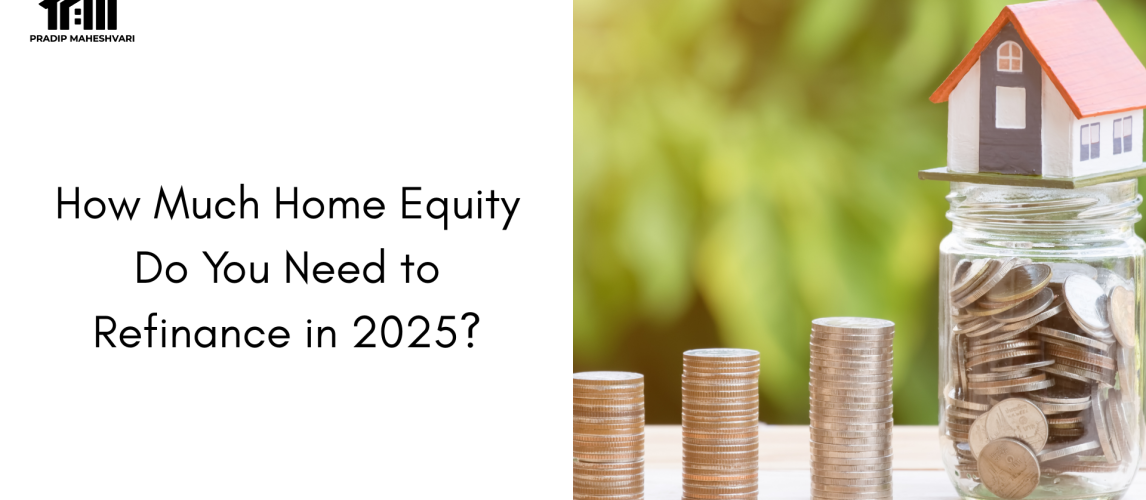Refinancing your mortgage can be a strategic financial decision, allowing you to lower your interest rate, adjust your loan term, or access home equity for large expenses. However, your ability to refinance hinges significantly on one critical factor: your home equity. In 2025, changing market conditions and lender policies make it essential to understand how much equity you need before initiating the process.
This guide outlines what home equity is, how much is typically required for refinancing, and what options are available based on your current financial position.
What Is Home Equity?
Home equity is the portion of your home’s value that you own outright. It is calculated by subtracting the balance of your existing mortgage from the current market value of your home. For example, if your home is worth $700,000 and you owe $420,000 on your mortgage, your home equity is $280,000.
Lenders use this figure to determine your loan-to-value (LTV) ratio, a key factor in refinancing eligibility. The LTV ratio compares your outstanding loan amount to your home’s value. A lower LTV indicates higher equity and less risk for the lender.
How Much Equity Is Needed to Refinance?
In Canada, most lenders require that your LTV ratio be no higher than 80 percent for a standard refinance. This means you must have at least 20 percent equity in your home to qualify under conventional lending rules.
Standard Refinance Example:
- Home value: $600,000
- Maximum loan allowed (80%): $480,000
- Existing mortgage: $400,000
- Available equity for refinancing: $80,000
In this scenario, you meet the equity requirement because your LTV is 66.7 percent.
However, equity requirements may vary depending on the type of refinance you pursue and the lender you work with.
Refinancing With Less Than 20% Equity
If you have less than 20 percent equity, refinancing may still be possible but with restrictions. These include:
1. High-Ratio Mortgage Refinance
A refinance with more than 80 percent LTV may be considered high-risk. In such cases, you might need mortgage default insurance through CMHC or a private insurer. This option is less common for refinances, as CMHC typically does not insure refinance loans in 2025.
2. Private or Alternative Lenders
Some private lenders may accept lower equity, sometimes refinancing up to 90 percent LTV. However, this comes at the cost of higher interest rates, shorter loan terms, and additional fees.
3. Home Equity Line of Credit (HELOC)
If your goal is to access equity rather than change your mortgage structure, a HELOC may be a viable solution. You typically need at least 20 percent equity to qualify, and borrowing limits are determined by your available equity and credit profile.
Factors That Influence Refinancing Eligibility
Beyond home equity, lenders evaluate several other criteria to assess whether you qualify for refinancing in 2025.
1. Credit Score
Most lenders look for a credit score of at least 650 for conventional refinancing. A higher score improves your chances of approval and helps secure better rates.
2. Income and Employment Stability
Proof of stable employment and sufficient income is required to show you can manage the new loan terms. Debt-to-income (DTI) ratios are carefully reviewed.
3. Property Type and Condition
Detached single-family homes in good condition are more favorably assessed than investment properties or older buildings needing repairs.
4. Appraisal Value
An up-to-date home appraisal is typically required to establish the current market value of your property and verify equity levels.
Why Refinance in 2025?
There are several strategic reasons to consider refinancing in the current economic climate:
- Lower interest rates: Secure a lower rate than your original mortgage, reducing your monthly payments.
- Access equity: Use built-up equity to pay off debts, invest in property upgrades, or fund major expenses.
- Switch loan types: Move from a variable to a fixed-rate mortgage or vice versa, depending on your risk tolerance.
- Adjust amortization: Shorten or extend your mortgage term to match your financial goals.
How to Prepare for Refinancing
If you plan to refinance in 2025, take these steps to ensure you meet home equity and lender requirements:
1. Check Your Mortgage Balance
Review your current mortgage statement to understand how much you still owe.
2. Get a Home Appraisal
A professional appraisal will give you an accurate estimate of your home’s current market value.
3. Calculate Your LTV
Divide your outstanding mortgage by the appraised value. If the ratio is 80 percent or less, you’re likely eligible for refinancing through traditional lenders.
4. Review Your Finances
Check your credit report, organize proof of income, and consider your current DTI ratio.
5. Consult a Mortgage Specialist
A licensed broker or advisor can evaluate your refinancing options, including whether a second mortgage, HELOC, or full refinance is best for your situation.
Conclusion
In 2025, most Canadian homeowners will need at least 20 percent equity to qualify for a traditional mortgage refinance. This threshold ensures an LTV ratio of 80 percent or lower, which most lenders consider the maximum for refinancing. If your equity is below this level, alternative financing options may still be available, but they typically involve higher rates and fees.
Before making a decision, assess your current equity, financial health, and long-term goals. Refinancing can be a powerful financial tool, but only when approached with full understanding and proper planning.
For personalized refinancing advice in Canada, Pradip Maheshvari can help you evaluate your home equity and choose the right solution.


No comment yet, add your voice below!